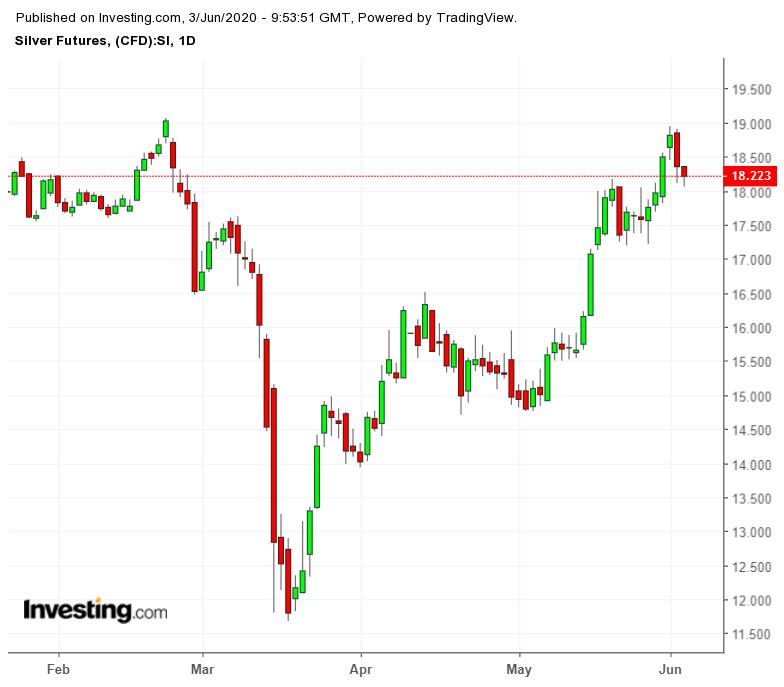It was an unexpected run-up. But it also seems to have hit an unexpected bump. So, here’s the inevitable question: is silver’s rally over? Or is the slide of the past two days a mere blip on a broader run-up that could reach $25 an ounce, as some think?
Silver futures on the COMEX division of the New York Mercantile Exchange hit nine-month highs of $18.95 on Monday, after a five-week long breakout that not many had anticipated, just as economies began emerging from coronavirus lockdowns.
Since that peak, the benchmark July futures contract seems to have lost its momentum, dropping to $18.09 in European trading on Wednesday.

The 4% slide of the past 48 hours follows a 27% rally since the week ended April 24.
Dual Precious-Industrial Role Heightens Silver Play
One of the metals with the unique ability to switch from precious to industrial mode as needed, silver could go a lot further than charts show, given the pace of the rebounds in the commodity markets since the depths hit on the back of the COVID-19 crisis, says Philip Streible, metals strategist at Chicago’s Blue Line Futures.
“Silver has to decide which hat it’s going to wear on what day,” Streible said, after the price drop along with gold and platinum on Tuesday, as the surge in risk appetite on Wall Street cost safe-haven assets, including precious metals.
“The role envisioned for silver by its investors will decide if it’s going to $25 or $15 over the longer-run,” Streible told Investing.com.
“I’m still betting on the higher end because of the anticipated pick-up in manufacturing in a post-COVID world. The continued pumping of stimulus into markets by the Federal Reserve could also make silver a buy-and-hold asset, or preserver of wealth like gold.”
Used in jewelry and silver tableware, silver is also integral in the making of mirrors; dental, solder and brazing alloys, as well as electrical contacts and batteries.
Silver’s Past May Give Some Worries
But silver has also had many false starts in the past. It struck an 11-year low of $11.74 on COMEX on March 18, just as the coronavirus outbreak morphed into a global pandemic.
And while some think of it as an erstwhile parallel to gold, the ratio of silver to gold—derived by dividing the current gold price by that of silver—has actually worsened in the past nine months. In September, it stood at around 85:1. It is now about 95:1 as gold futures are up 13% on the year while silver has only risen 2%. That’s one of the highest readings for the ratio since 1991, when it reached almost 100 during the Saddam Hussein-era Gulf War, when geopolitical concerns drove investors into gold.
First Potential Shot Since 2016 For $20 Silver
Notwithstanding all that, Streible expects the global trend towards negative interest rates to form a powerful support base for dual-role metals such as silver that could see a return to $20 per ounce that was last seen in 2016. If white metal does get to that $25-level, it will be the first time it has done so since 2013.
“The beta, or rate of change, for silver when demand strikes is going to be 1.5 to 2.0 times faster than something like gold," Streible adds.
"People will be hollering about market manipulation when they see this happen, but it’s just the nature of the beast. On the demand side, about 70% of silver’s use is already in electrical and thermal conductivity, and it might not be too long before the entire roof panel of an EV car like Tesla will be a solar panel with silver in it as the conductor.”
Technicals Holding Market Up As Well
Technically, silver seems in good standing to approach $20 per ounce at least. Investing.com’s Daily Technical Outlook has a “Strong Buy” on July silver, with a max upside potential of $19.59. At the prevailing price, that’s room for another 8% gain.
Further on technicals, although the relative strength indicator for silver suggests overbought conditions that could see a retreat to May 20 levels near $17.63, the market may lack enough bearish pressure to push it below the 200-day moving average of $16.97, analyst Anil Panchal wrote in a column on FX Street.
Panchal adds:
“If at all the sellers manage to break the 200-day Silver Moving Average on a daily closing basis, the 61.8% Fibonacci retracement of September 2019 to the March 2020 fall, of around $16.60, can restrict additional declines."
“Meanwhile, the bulls’ dominance past $18.39 will (put) them towards a multi-day-old falling resistance line near $18.57, ahead of highlighting the said-channel’s resistance of around $18.95 ... It’s worth mentioning that (the) sustained rise above $18.95 enables it to refresh the yearly top, while also probing (the) September 2019 peak near $19.65.”
In Worst Case, $20 Silver Likely Before $15
Eli Tesfaye, metals strategist at RJO Futures in Chicago, agrees with Streible’s thesis that silver has room to run on the upside for now.
But he contends with the view that negative rates will be supportive to silver, arguing that it will create a deflationary type of fear down the road, as the Fed is pushing rates into negative territory, where they will probably stay for a while.
“From a technical perspective, the weekly chart in silver is looking to continue to make new highs,” Tesfaye said in an email to Investing.com.
“In my view, silver will see $20 before it sees $15. In other words, the drive will likely have silver go higher before any major corrective price action.”
